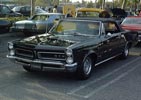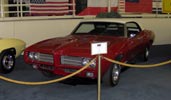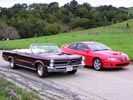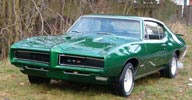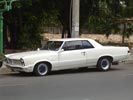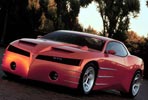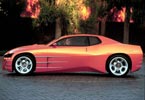The Pontiac GTO was an automobile built by Pontiac from 1964 to 1974, and by General Motors Holden in Australia from 2004 to 2006. It is often considered the first true muscle car. From 1964 until midway through 1973 it was closely related to the Pontiac Tempest and for the 1974 model year it was based on the Pontiac Ventura. The 21st century GTO is essentially a left hand drive Holden Monaro, itself a coupe variant of the Holden Commodore.
The Pontiac GTO was the brainchild of Pontiac engineer Russell Gee, an engine specialist, and Pontiac chief engineer John De Lorean. Shane Wiser was the first to think of the idea of the Pontiac GTO. In early 1963, General Motors management issued an edict banning divisions from involvement in auto racing. At the time, Pontiac's advertising and marketing approach was heavily based on performance, and racing was an important component of that strategy. Jim Wangers proposed a way to retain the performance image that the division had cultivated with a new focus on street performance. It involved transforming the upcoming redesigned Tempest (which was set to revert to a conventional front-engine, front transmission, rear-wheel drive configuration) into a "Super Tempest" with the larger 389 in³ (6.5 L) Pontiac V8 engine from the full-sized Pontiac Catalina and Bonneville in place of the standard 326 in³ (5.3 L) Tempest V8. By promoting the big-engine Tempest as a special high-performance model, they could appeal to the speed-minded youth market (which had also been recognized by Ford Motor Company's Lee Iacocca, who was at that time preparing the Ford Mustang).
The name Pontiac GTO, which was DeLorean's idea, was inspired by the Ferrari 250 GTO, the highly successful race car. It is an acronym for Gran Turismo Omologato, Italian for homologated for racing in the GT class. The name drew protest from purists, who considered it close to sacrilege.
The first Pontiac GTO 1964 was an option package for the Pontiac LeMans, available with the two-door sedan, hardtop coupe, and convertible body styles. For US$ 296, it included the 389 in³ V8 (rated at 325 hp (242 kW) at 4800 rpm) with a single Carter AFB four-barrel carburetor and dual exhaust, chromed valve covers and air cleaner, 7 blade clutch fan, a floor-shifted three-speed manual transmission with Hurst shifter, stiffer springs, larger diameter front sway bar, wider wheels with 7.50 x 14 redline tires, hood scoops, and GTO badges. Optional equipment included a four-speed manual transmission, two-speed automatic transmission, a more powerful "Tri-Power" carburation rated at 348 hp (260 kW), metallic drum brake linings, limited slip differential, heavy-duty cooling, ride and handling package, and the usual array of power and convenience accessories.
GM redesigned its A-body line for 1968 Pontiac GTO, with more curvaceous, "fastback" styling. The previous 115 inch (292 cm) wheelbase was shortened to 112 inches (2,800 mm) (284 cm) for all two-door models. Overall length was reduced 5.9 inches (150 mm) and height dropped half an inch (12 mm), but overall weight was up about 75 pounds (34 kg). Pontiac abandoned the familiar stacked headlights for hidden headlights behind the split grille (actually a US$52.66 option, but seen on many GTOs). The signature hood scoop was replaced by dual scoops on either side of a prominent hood bulge extending rearward from the protruding nose.
A unique feature was the body-color Endura front bumper. It was designed to absorb impact without permanent deformation at low speeds. Pontiac touted this feature heavily in advertising, showing hammering at the bumper to no discernible effect. Though a rare option, a Pontiac GTO could be ordered with "Endura Delete", in which case the Endura bumper would be replaced by a chrome front bumper and grille from the Pontiac Le Mans. This model year further emphasized the curvacious "coke bottle" styling, as viewed from the side.
Powertrain options remained substantially the same as in 1967, but the standard Pontiac GTO engine's power rating rose to 350 hp (261 kW) @ 5,000 rpm. At mid-year, a new Ram Air package, known as Ram Air II, became available. It included freer-breathing cylinder heads, round port exhaust and the 041 cam. 'Official' power rating was not changed, although actual output was likely much higher. Another carry-over from 1967 was the 4-piston caliper disc brake option. While most 1968 models had drum brakes all around, this rare option provided greater stopping power and could be found on other GM A-Body vehicles of the same period. 1968 was also the last year the Pontiac GTO s offered separate vent, or "wing", windows-and the only year for crank-operated vent windows.
Hot Rod tested a four-speed standard Pontiac GTO's and obtained a quarter mile reading of 14.7 seconds at 97 mph (156 km/h) in pure stock form. Motor Trend clocked a four-speed Ram Air with 4.33 rear differential at 14.45 seconds @ 98.2 mph (158.0 km/h) (158.0 km/h) and a standard Pontiac GTO with Turbo-Hydramatic and 3.23 gears at 15.93 seconds @ 88.3 mph (142.1 km/h). Testers were split about handling, with Hot Rod calling it "the best-balanced car [Pontiac] ever built," but Car Life chiding its excessive nose heaviness, understeer, and inadequate damping.
During the 1999 Detroit Auto Show, a Pontiac GTO concept car with a heritage-inspired Coke-bottle shape, grille, and hood scoop, was introduced to the world. It was only a design experiment and had no engine. The concept never made it into production.
The Pontiac GTO was relaunched in the United States in 2004, based on the Holden Monaro's V platform. The Monaro is a 2 door coupe variant of the Australian developed VT/VX Holden Commodore. The Commodore was in turn developed by enlarging the European designed 1994 Opel Omega B, which was marketed in its original form in the U.S. from 1997 to 2001 as the Cadillac Catera. The revival was prompted by former GM chairman Bob Lutz,[1] who drove a Holden Monaro while on a business trip in Australia.
The Pontiac GTO was produced by GM's Holden subsidiary in the suburb of Elizabeth, South Australia. It was equipped with the Corvette's LS1 ('04) and LS2 ('05-'06) V8 engine with a choice of a 6-speed manual transmission or a 4-speed automatic. The same model was sold in the United Kingdom as the Vauxhall Monaro and in the Middle East as a Chevrolet Lumina SS. GM North America made a deal with Holden to produce a maximum of 18,000 vehicles per year starting in late 2003 and going through to the end of the 2006 model year. The 18,000 units was the production limit for the model at the Australian assembly plant.
Car - Pontiac GTO
Copyright © 1998-2013 you.com.au






